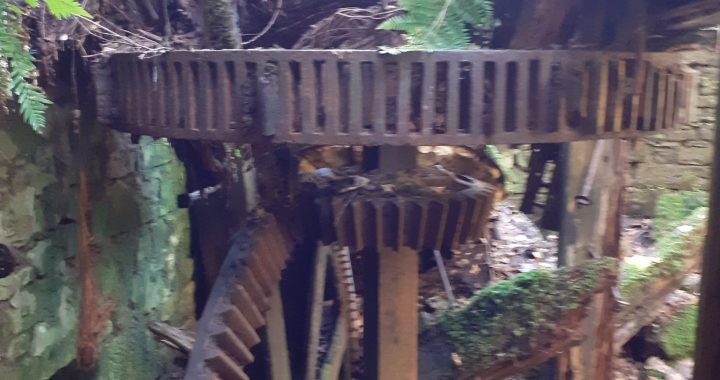Mill gearing – between water wheel and grindstones
Minor Mills on Millbank Burn and the Calder
Several burns flow into Barr Loch on the way to the Black Cart. The largest of these burns is Millbank Burn which powered Millbank Mill, a traditional grain mill. Until about a decade ago the mill’s grinding stones and large water wheel were still intact.
Between the burn and Barr Castle, water was collected from a copious spring to turn another waterwheel to pump water out of the then drained Barr Loch (discussed in a previous Advertizer article).
The main watercourse in the headwaters of the Black Cart is the Calder which falls into Castle Semple Loch at Lochwinnoch. The Calder falls 400 metres from Queenside Loch down to Castle Semple Loch. The stream and its smaller feeder burns, particularly the Cloak Burn, powered numerous mills which ranged in size from the humblest grain mills to the biggest cotton mills.
This month we look at the Calder’s smaller mills. Up on the moors at Muirshiel, the Calder powered a mill for grinding Barytes (discussed in a previous Advertizer article). Further down the Calder were two lint mills, at Loups and at Bridgend, the latter of which at one time was also a grain mill. Another lint mill sat on the Cloak Burn. There were also several bleachfields on the edge of Lochwinnoch village, for whitening and finishing cloth. One lay beside the Calder at Burnfoot, at the bottom of the minor Garple Burn. Another two, the Old and New Bleachfields, at Calderhaugh, were advertised from 1793.
It took considerable ingenuity to power a variety of mills from such a powerful and unpredictable burn as the Calder. Water rights were a thorny issue and even the mighty Castle Semple owners did not escape disputes. From the 1790s the flow in the Calder in dry spells was controlled by the owners of dams recently built on the Calder at Queenside Loch and on the Cloak Burn at Knockbartnock.
James Adam of Barr owned the Glen Mill on the Cloak Burn, which had been a corn mill for at least 150 years. It had full rights to the mill dams and lades on the Cloak burn, including the Black Linn, Boghead and Kaim dams. However the owners of the new cotton mills had closed the dam sluices for weeks to store up water for dry weather. This stopped the working of Glen Mill. However the traditional water rights were upheld and the cotton mill owners were instructed to provide enough water for Adam to drive his modest grain mill. Cotton mills will be the subject of a future article.
© 2016, Stuart Nisbet

